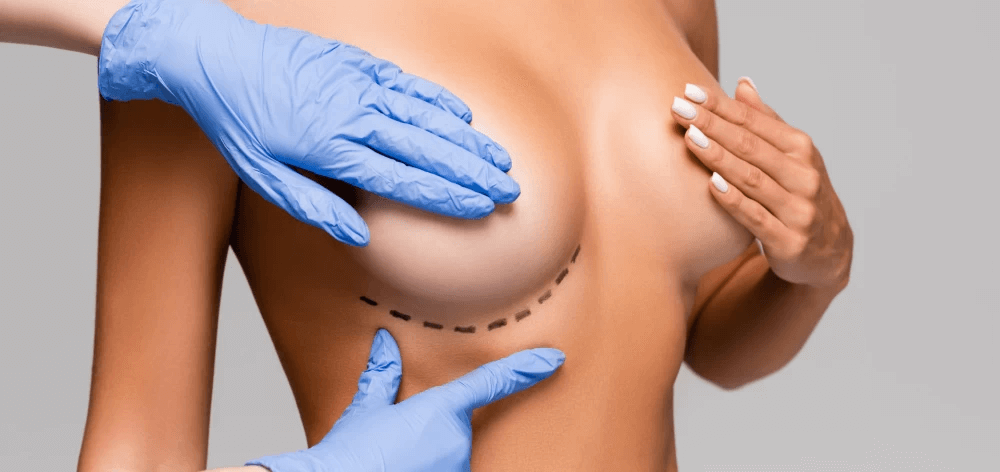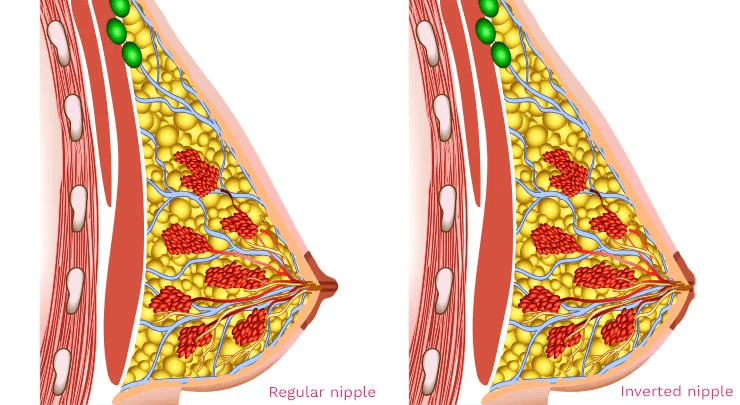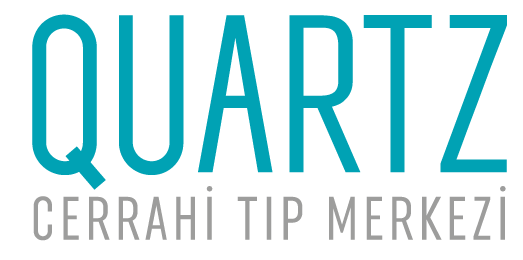
Contents

Inverted nipple surgery, also known as nipple inversion correction, is a minimally invasive surgical procedure designed to correct nipples that are retracted inward rather than projecting outward. Affecting approximately 10–20% of women, nipple inversion can be present from birth or develop over time due to breastfeeding, aging, trauma, or surgical scarring. While often considered an aesthetic concern, severe cases may interfere with breastfeeding, lead to hygiene problems, or cause psychological distress.
What Is Inverted Nipple Surgery?
Inverted nipple surgery is usually performed on an outpatient basis and takes around 30 minutes. It is typically done under local anesthesia, though sedation or general anesthesia may be used depending on patient preference or combination with other breast surgeries.
Key Surgical Steps:
- A small incision is made at the base of the nipple or within the areola.
- Fibrous bands or shortened milk ducts causing traction are released or severed.
- The nipple is everted and sutured in an outward position.
- In many cases, the surgeon may use duct-preserving techniques to maintain future breastfeeding capability.
- A supporting structure such as a dermal flap, internal stitch, or stent may be used to reduce the risk of recurrence.
- Surgery can be combined with augmentation, breast lift, or reduction.
Nipple Inversion Grades
Nipple inversion is commonly classified into three grades based on its severity and the ability to evert the nipple manually. Grade 1 represents the mildest form, where the nipple can be easily protracted, while Grade 3 indicates a severe and fixed inversion that often requires surgical correction. This classification helps determine the most suitable treatment approach and predict the likelihood of successful correction without surgery.
| Grade | Description | Reversibility |
|---|---|---|
| Grade 1 | Nipple retracts occasionally, can be pulled out manually | High |
| Grade 2 | Nipple is often retracted, but can be pulled out with moderate traction | Moderate |
| Grade 3 | Nipple is severely inverted and cannot be pulled out manually | Low |
Duct-Preserving Surgical Techniques
Certain techniques aim to correct the inversion without cutting the lactiferous ducts, which is particularly important for women who wish to breastfeed in the future.
| Technique | Description | Breastfeeding Potential |
|---|---|---|
| Hong & Lee Flap Technique | Uses dermal flaps without disrupting ducts | High |
| Yamamoto’s Technique | Involves radial incisions and purse-string sutures | Moderate–High |
| Tunnel Method | Creates a subcutaneous tunnel, avoiding ducts | High |
| Parachute Flap | Utilizes V-shaped dermal flaps for structural support | Moderate |
Note: Even with duct preservation, not all patients will retain full breastfeeding function.
Alternatives to Surgery: Non-Surgical Options
For mild to moderate inversion (Grade 1–2), non-surgical methods may be considered before resorting to surgery:
- Nipple suction devices (e.g., Avent Niplette)
- Breast pump stimulation
- Manual traction techniques during pregnancy or lactation
- Silicone suction cups or nipple correctors
- Piercing-based traction (experimental and not widely recommended)
These options may provide temporary relief or partial correction, especially in breastfeeding preparation. However, Grade 3 inversions typically require surgery for a lasting solution.
Who Is a Good Candidate for Inverted Nipple Surgery?
- Women or men with persistent Grade 2 or 3 inversion
- Patients experiencing recurrent infections, rashes, or hygiene issues
- Individuals with aesthetic concerns or self-esteem issues
- Patients planning breast augmentation or lift, desiring correction at the same time
- Those not planning to breastfeed or willing to accept the possible loss of function
Benefits of Inverted Nipple Correction
- Restores natural projection of the nipple
- Enhances breast symmetry and aesthetics
- Reduces social embarrassment or psychological distress
- May improve breastfeeding potential (if ducts preserved)
- Helps reduce skin irritation, inflammation, and hygiene issues
Risks and Complications
While generally safe, potential risks include:
- Loss of nipple sensation (temporary or permanent)
- Recurrence of inversion, especially if milk ducts are preserved
- Scarring, typically hidden in the areolar border
- Infection, swelling, or delayed wound healing
- Inability to breastfeed if ducts are severed
Recovery Timeline: What to Expect After Surgery
Recovery after inverted nipple surgery is typically smooth and quick. While minor swelling or bruising is expected in the first few days, most patients can resume daily activities within a week. Below is a general timeline for the healing process.
| Timeframe | Recovery Milestone |
|---|---|
| Day 1–2 | Swelling, mild bruising, discomfort; rest recommended |
| Day 3–7 | Most patients return to light activities; dressings may be removed |
| Day 7–10 | Sutures removed (if non-absorbable); nipple support device removed if used |
| Week 2–3 | Resume light exercise; avoid nipple stimulation |
| Week 4–6 | Final shape and sensitivity improvements become apparent |
Tips for Post-Op Care:
- Keep incision area clean and dry
- Use prescribed antibiotic creams or ointments
- Avoid direct pressure or trauma to the nipples
- Wear soft, non-restrictive bras or go without bras temporarily
- Attend all scheduled follow-up appointments
Long-Term Results and Recurrence
Most patients report high satisfaction with the aesthetic result and improved self-esteem. However:
- Recurrence may occur in up to 10–15% of cases
- Results are more stable in techniques that sacrifice ducts
- Sensitivity may gradually improve over 6–12 months
- Scar visibility is minimal if healing is optimal
Cost of Inverted Nipple Surgery
The cost of inverted nipple surgery varies depending on the surgeon’s expertise, clinic location, and whether the procedure is performed alone or in combination with other breast surgeries. While generally affordable, this procedure is often considered cosmetic and may not be covered by insurance.
| Country | Average Cost (Both Nipples) |
|---|---|
| USA | $1,500 – $4,500 |
| UK | £1,500 – £3,800 |
Note: Most insurance plans do not cover this procedure unless there is documented medical necessity.
Inverted nipple surgery offers a lasting solution for patients struggling with retracted nipples, whether for cosmetic reasons, functional concerns, or both. With advanced duct-preserving techniques and rapid recovery times, the procedure has become a safe and effective choice for long-term nipple correction.
Frequently Asked Questions (FAQs)
Can I still breastfeed after the surgery?
Yes, if milk ducts are preserved using specialized techniques. However, there’s no guarantee of full lactation function.
Is the procedure painful?
No, the surgery is performed under local or general anesthesia. Postoperative discomfort is mild and managed with simple painkillers.
Will my nipple look natural?
Yes. The goal of the surgery is to restore natural projection while keeping scars nearly invisible.
How long do the results last?
Most patients experience permanent correction, though recurrence can occur in some cases.
Can men have inverted nipple surgery?
Absolutely. Although less common, men with inverted nipples due to genetics or trauma may also undergo this procedure.
Is there any risk of cancer or long-term damage?
No. The procedure does not increase cancer risk and does not affect overall breast health.
![dr.leyla-arvas-800×1000.jpg[1] dr.leyla arvas](https://www.quartz.com.tr/wp-content/uploads/2024/11/dr.leyla-arvas-800x1000.jpg1_.webp)
Author : Op. Dr Leyla ARVAS
Dr Leyla Arvas is an internationally recognised specialist in aesthetic surgery based in Istanbul. Graduated in 1998 from Istanbul University Faculty of Medicine, she has developed her expertise by studying in Taiwan, Japan and Spain during her 20 years of experience.
This article December 26, 2025 was updated on
Editor: admin@quartz.com.tr



